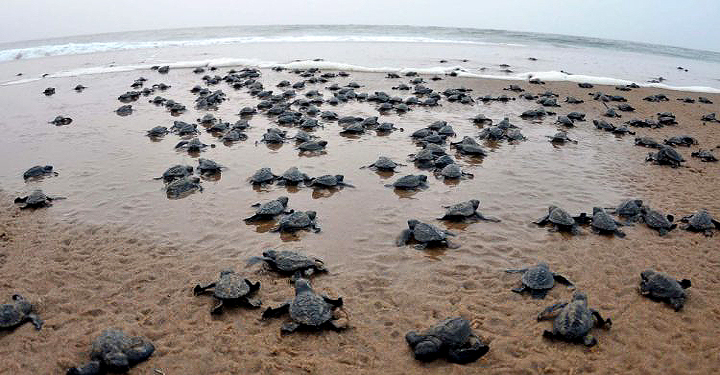Bhubaneswar: The Odisha government will ban fishing for seven months from November around the sites where the endangered olive ridley turtles congregate for mass nesting.
Chief Secretary Suresh Chandra Mohapatra directed various departments to ensure concerted efforts at the ground level in conservation and nurturing of the olive ridleys, according to an official release Tuesday.
During a virtual meeting of a high-level committee on the conservation of olive ridley Monday, Mohapatra stressed on the need to actively involve all stakeholders, NGOs and local community in such measures.
Olive ridley turtles — one of the species of the sea turtle under the red list of the International Union for Conservation of Nature — turn up in millions for mass nesting along the Odisha coast every year.
The reptiles lay eggs at the Gahirmatha beach in Kendrapara district, the Rushikulya river mouth in Ganjam district and the Devi river mouth in Puri district.
Fishing by motorised vessels or trawlers and mechanised techniques will be banned from November 1 till May 31 within 20 km from the coast where the congregation area is located and the buffer zones in the river mouths of Dhamra, Devi and Rushikulya.
The Coast Guard was requested to share real-time intelligence with the departments about any illegal fishing, the release stated.
Fisheries Secretary R Raghu Prasad said a mobile app has been developed to help the fisherfolk in knowing the no-fishing zone and get an alert when they enter such an area.
The chief secretary directed all officers engaged in the conservation operation to download the app for asserting the location of the fishing boats.
The Defence Research and Development Organisation, and the ports of Dhamra, Gopalpur and Paradip were requested to follow the black-out practices and light-deeming to save turtles from possible delusion.
The port authorities were asked to provide necessary support for joint patrolling in the sea and berthing of the vessels.
At the meeting to discuss the action plan for 2021-22, it was decided that sporadic nesting activities of the turtles and their mortality will be monitored through a web portal. The rookeries will be fenced soon after mass nesting to protect the nests and eggs.
A total number of 66 patrolling camp sites, including five off-shore camps, will be operated round the clock.
Additional Chief Secretary (Forest) Mona Sharma said the state’s four wildlife divisions — Bhadrak, Rajnagar, Puri and Berhampur — have been equipped with five high-speed boats, 13 trawlers and support boats for chasing the illegal activities in the sea.
In the last nesting season, around 3.5 lakh turtles laid eggs in the Gahirmatha coast. Thirty eight trawlers were seized and 202 people were arrested, Principal Chief Conservator of Forests (Wildlife) Shashi Paul said.
“As we have earned more experience and the state is investing large amounts of money for the purpose (conservation, we must deliver the best in saving this species for the world community,” the chief secretary said.
During ‘arribada’ (arrival by sea in Spanish), female turtles reach beaches usually at the dead of the night for laying eggs. After that, they return to the sea.
An olive ridley usually lays about 120-150 eggs and the hatchlings, after emerging from these eggs in a span of 45 to 60 days, travel to the sea. They grow up without their mothers.
Reports suggest that out of every 1,000 hatchlings that enter the sea, only one manages to reach adulthood, according to Odisha Tourism.
PTI
